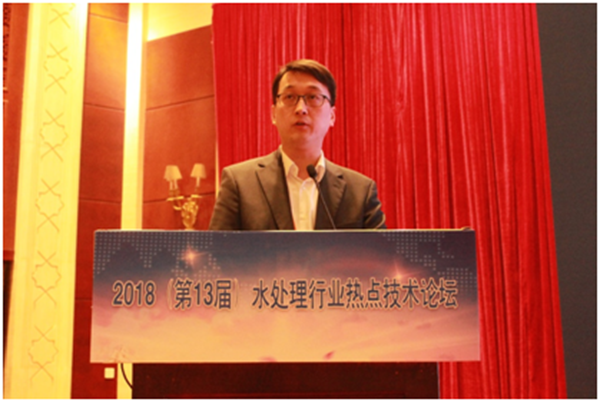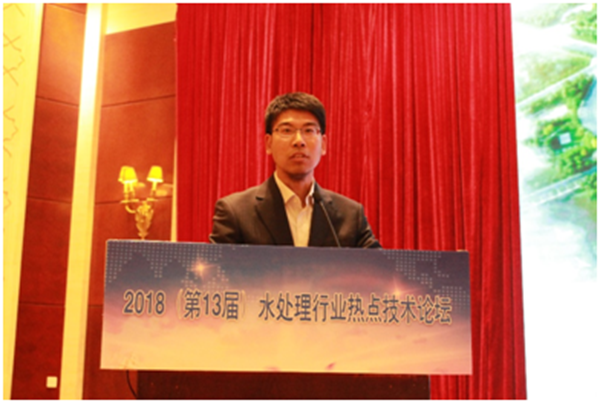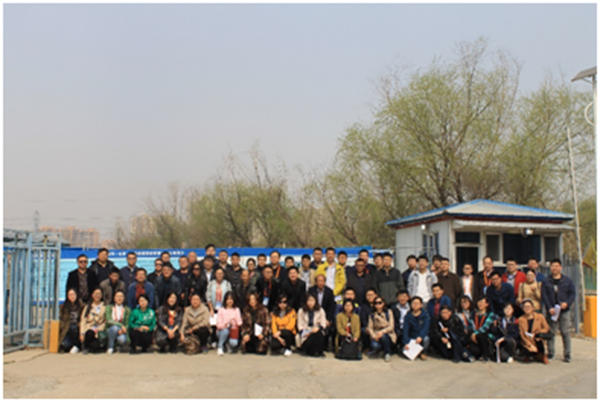CWEG Successfully Co-organized the 13th Red-hot Water Treatment Technologies Forum
2018-03-30 On March 29 to 30, 2018, the 13th Red-hot Water Treatment Technologies Forum kicked off in Xinjiang Hotel, Beijing. The forum was co-sponsored by the National Engineering Laboratory “Advanced Treatment and Utilization Technology for Municipal Wastewater” and the Construction Industry Branch of the China Council for the China Council for the Promotion of International Trade (CCPIT), and jointly held by CWEG, bringing together over 400 experts, scholars, leaders, and enterprise representatives to discuss on the development of the water treatment technology industry. Pao Hongtao, Deputy General Manager of CWEG Beijing Technology R&D Center, and Cao Xiaoxin, Senior Manager of CWEG Beijing Technology R&D Center, shared the group’s successful practices in this industry. After the forum, expert representatives visited the Beijing Bishui Underground WWTP Upgrading Project.

Themed “Urban Water Environment Management”, the forum fell into four keynote sessions of “Urban WWTP”, “Urban Water Environment Management Explorations and Practices”, “Urban Sludge Treatment” and “Water Environment Management and the Application of New Technical Equipment”. Li Zheng, Director of the Construction Industry Branch of the China Council for CCPIT, and Zhang Linwei, Deputy Director of the Urban Construction Department of the Ministry of Housing and Urban-Rural Development, addressed the forum. Peng Yongzhen, Director of the National Engineering Laboratory “Advanced Treatment and Utilization Technology for Municipal Wastewater” , academician of the Chinese Academy of Engineering and Chief Professor of Environmental Science and Engineering at Beijing University of Technology, delivered an important speech.
In the keynote session of “Water Environment Management and the Application of New Technical Equipment”, Pao Hongtao systematically introduced the Guang’an “Clean Water Action” Regional Water Environment Management Project successfully implemented by CWEG. The project is the first regional and cross-watershed water environment management demonstration project in China, serving 1 city, 2 national industrial parks, 3 counties and 108 villages and townships. Through overall planning “at the municipal, county and town levels”, the project adopts the layout of “One central WWTP + multiple satellite WWTPs”, and uses Internet of Things technology to realize intelligent rural WWTP operation, thus prompting poverty alleviation. In addition, by “leaving professional fields to experts”, the project also brings a package of urban wastewater treatment, rural wastewater treatment, river/lake/reservoir pollution control sub-projects, etc. within the whole region together for integrated optimization and implementation, saving RMB 650 million of investment, shortening the construction time by 12 months and achieving satisfactory initial effects. The Sichuan provincial government has called on the whole province to study and promote the “Guang’an Mode” of the project, in a bid to create a good environment for investment attraction and industrial upgrading, and greatly reduce financial burden on the local government.

At the forum, Cao Xiaoxin made a report entitled “Reflections on the Practice of Beijing Tongzhou Bishui Underground WWTP Upgrading”, in which the project background, technological process and key parameters were introduced in detail. The Bishui Underground WWTP is an example that truly realizes the goal of “eco-friendliness, land intensiveness and resource utilization” through innovating the mechanism, planning concept and technology, ensuring a good water environment for Beijing’s sub-center Tongzhou.

After the closing of the forum, on the morning of March 31, nearly 120 representatives from scientific research institutions, enterprises and relevant organizations visited CWEG’s Beijing Tongzhou Bishui Underground WWTP Project to learn its advanced and successful experience in WWTP renovation and construction. They highly praised the project as an example that truly realizes the goal of “eco-friendliness, land intensiveness and resource utilization” and contributes significantly to the improvement of the city’s water environment.

Pao Hongtao, Deputy General Manager of CWEG Beijing Technology R&D Center
Themed “Urban Water Environment Management”, the forum fell into four keynote sessions of “Urban WWTP”, “Urban Water Environment Management Explorations and Practices”, “Urban Sludge Treatment” and “Water Environment Management and the Application of New Technical Equipment”. Li Zheng, Director of the Construction Industry Branch of the China Council for CCPIT, and Zhang Linwei, Deputy Director of the Urban Construction Department of the Ministry of Housing and Urban-Rural Development, addressed the forum. Peng Yongzhen, Director of the National Engineering Laboratory “Advanced Treatment and Utilization Technology for Municipal Wastewater” , academician of the Chinese Academy of Engineering and Chief Professor of Environmental Science and Engineering at Beijing University of Technology, delivered an important speech.
In the keynote session of “Water Environment Management and the Application of New Technical Equipment”, Pao Hongtao systematically introduced the Guang’an “Clean Water Action” Regional Water Environment Management Project successfully implemented by CWEG. The project is the first regional and cross-watershed water environment management demonstration project in China, serving 1 city, 2 national industrial parks, 3 counties and 108 villages and townships. Through overall planning “at the municipal, county and town levels”, the project adopts the layout of “One central WWTP + multiple satellite WWTPs”, and uses Internet of Things technology to realize intelligent rural WWTP operation, thus prompting poverty alleviation. In addition, by “leaving professional fields to experts”, the project also brings a package of urban wastewater treatment, rural wastewater treatment, river/lake/reservoir pollution control sub-projects, etc. within the whole region together for integrated optimization and implementation, saving RMB 650 million of investment, shortening the construction time by 12 months and achieving satisfactory initial effects. The Sichuan provincial government has called on the whole province to study and promote the “Guang’an Mode” of the project, in a bid to create a good environment for investment attraction and industrial upgrading, and greatly reduce financial burden on the local government.

Cao Xiaoxin, Senior Manager of CWEG Beijing Technology R&D Center
At the forum, Cao Xiaoxin made a report entitled “Reflections on the Practice of Beijing Tongzhou Bishui Underground WWTP Upgrading”, in which the project background, technological process and key parameters were introduced in detail. The Bishui Underground WWTP is an example that truly realizes the goal of “eco-friendliness, land intensiveness and resource utilization” through innovating the mechanism, planning concept and technology, ensuring a good water environment for Beijing’s sub-center Tongzhou.

Attendees visited the Beijing Tongzhou Bishui Underground WWTP
After the closing of the forum, on the morning of March 31, nearly 120 representatives from scientific research institutions, enterprises and relevant organizations visited CWEG’s Beijing Tongzhou Bishui Underground WWTP Project to learn its advanced and successful experience in WWTP renovation and construction. They highly praised the project as an example that truly realizes the goal of “eco-friendliness, land intensiveness and resource utilization” and contributes significantly to the improvement of the city’s water environment.
 中国水环境集团
中国水环境集团









